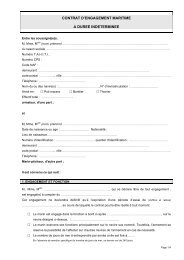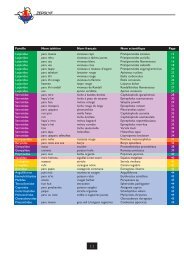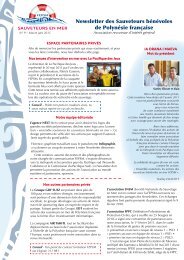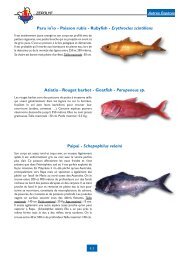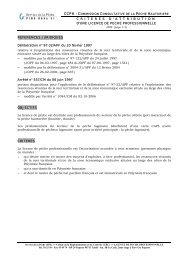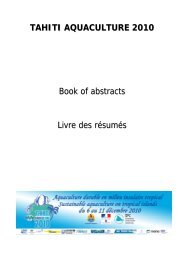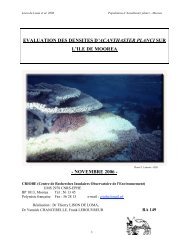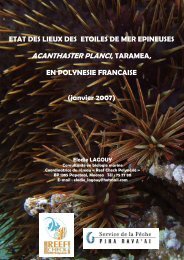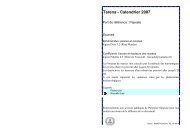Commission for the Conservation and ... - Site de la pêche
Commission for the Conservation and ... - Site de la pêche
Commission for the Conservation and ... - Site de la pêche
You also want an ePaper? Increase the reach of your titles
YUMPU automatically turns print PDFs into web optimized ePapers that Google loves.
85. Four CCMs, two of whom are also members of <strong>the</strong> NC, joined <strong>the</strong> Chair in expressing <strong>the</strong>ir<br />
concern regarding <strong>the</strong> exemption <strong>for</strong> <strong>the</strong> Korean EEZ <strong>and</strong> <strong>the</strong> need to implement <strong>the</strong> management<br />
measures across all fisheries catching Pacific bluefin tuna as of 2011.<br />
86. Korea stated that <strong>the</strong> catch of Pacific bluefin, most of which occurs around Cheju Isl<strong>and</strong>, is<br />
mainly bycatch <strong>and</strong> amounts to less than 1,500 t. Korea is un<strong>de</strong>rtaking a research programme<br />
costing over US$ 1 million to un<strong>de</strong>rst<strong>and</strong> more about <strong>the</strong> status <strong>and</strong> catch of <strong>the</strong> species in Korean<br />
waters.<br />
87. In response to <strong>the</strong> preceding intervention by Korea, Japan queried <strong>the</strong> characterization of<br />
Korea‘s Pacific bluefin tuna catch as bycatch based on a comparison with its own records from<br />
<strong>the</strong> area. Korea corrected its statement on bycatch by saying that, in Korean <strong>la</strong>w, <strong>the</strong>re is no<br />
concept of bycatch or target species. Fishing licenses are permitted by fishing gear type <strong>and</strong><br />
purse-seine vessels mainly targeting mackerels take Pacific bluefin tun,a which accounts <strong>for</strong> less<br />
than 1% of total catch by <strong>the</strong> purse-seine vessels.<br />
88. In response to a separate question regarding catches of juvenile Pacific bluefin tuna by<br />
purse-seine vessels, Japan exp<strong>la</strong>ined that it has implemented a voluntary minimum fish size limit<br />
of 2 kg <strong>for</strong> purse-seine vessels. Japan also exp<strong>la</strong>ined its intention to introduce a programme to<br />
collect in<strong>for</strong>mation on Pacific bluefin tuna imported from Korea. Comments regarding <strong>the</strong><br />
importance of Mexico in <strong>de</strong>veloping management measures <strong>for</strong> this species were reiterated (see<br />
Section 2.2).<br />
89. The IATTC in<strong>for</strong>med WCPFC that its staff will soon recommend a simi<strong>la</strong>r management<br />
measure <strong>for</strong> Pacific bluefin tuna <strong>for</strong> IATTC adoption. The IATTC holds substantial observer data<br />
on Pacific bluefin tuna catches <strong>and</strong> <strong>the</strong>se data, <strong>and</strong> IATTC expertise, are being shared with <strong>the</strong><br />
ISC <strong>for</strong> scientific purposes.<br />
90. The NC Chair announced that a joint meeting between <strong>the</strong> NC <strong>and</strong> IATTC is p<strong>la</strong>nned in<br />
or<strong>de</strong>r to discuss Pacific bluefin tuna management measures across <strong>the</strong> North Pacific <strong>and</strong> that<br />
CCMs <strong>and</strong> scientists will be invited to attend.<br />
91. With regard to <strong>the</strong> NC‘s recommen<strong>de</strong>d revised CMM <strong>for</strong> North Pacific albacore (WCPFC-<br />
2009/DP06 which, if adopted, would rep<strong>la</strong>ce CMM 2005-03), <strong>the</strong> NC Chair highlighted that<br />
concerns expressed by o<strong>the</strong>r CCMs, which are not members of <strong>the</strong> NC, centre on <strong>the</strong> sou<strong>the</strong>rn<br />
extent of <strong>the</strong> applicable area of <strong>the</strong> CMM: ei<strong>the</strong>r north of 20 o north <strong>la</strong>titu<strong>de</strong> or north from <strong>the</strong><br />
equator. This issue is fur<strong>the</strong>r discussed un<strong>de</strong>r Agenda Item 9.1.<br />
92. Two CCMs, who are also NC members, noted that <strong>the</strong> <strong>la</strong>st assessment <strong>for</strong> North Pacific<br />
albacore was conducted in 2006 based on data from 2005 <strong>and</strong> expressed concern that <strong>the</strong> next<br />
assessment is not scheduled until 2011. It was consi<strong>de</strong>red by <strong>the</strong>se CCMs that a stock assessment<br />
should occur at least every third year.<br />
93. The Chair of <strong>the</strong> ISC stated that constraints on staffing <strong>and</strong> funding prohibit more frequent<br />
stock assessments being carried out. In addition, much of <strong>the</strong> biological data necessary <strong>for</strong> <strong>the</strong><br />
assessments is old <strong>and</strong> needs to be re-assessed. ISC also needs to find time to progress<br />
<strong>de</strong>velopment of reference points. For <strong>the</strong>se reasons, ISC will progress stock assessments in as<br />
timely <strong>and</strong> responsive a manner as possible given <strong>the</strong> substantial constraints.<br />
94. FFA members stated that all scientific advice should be channelled to <strong>the</strong> <strong>Commission</strong><br />
through <strong>the</strong> SC in or<strong>de</strong>r to promote consistency of st<strong>and</strong>ards <strong>and</strong> processes.<br />
15





